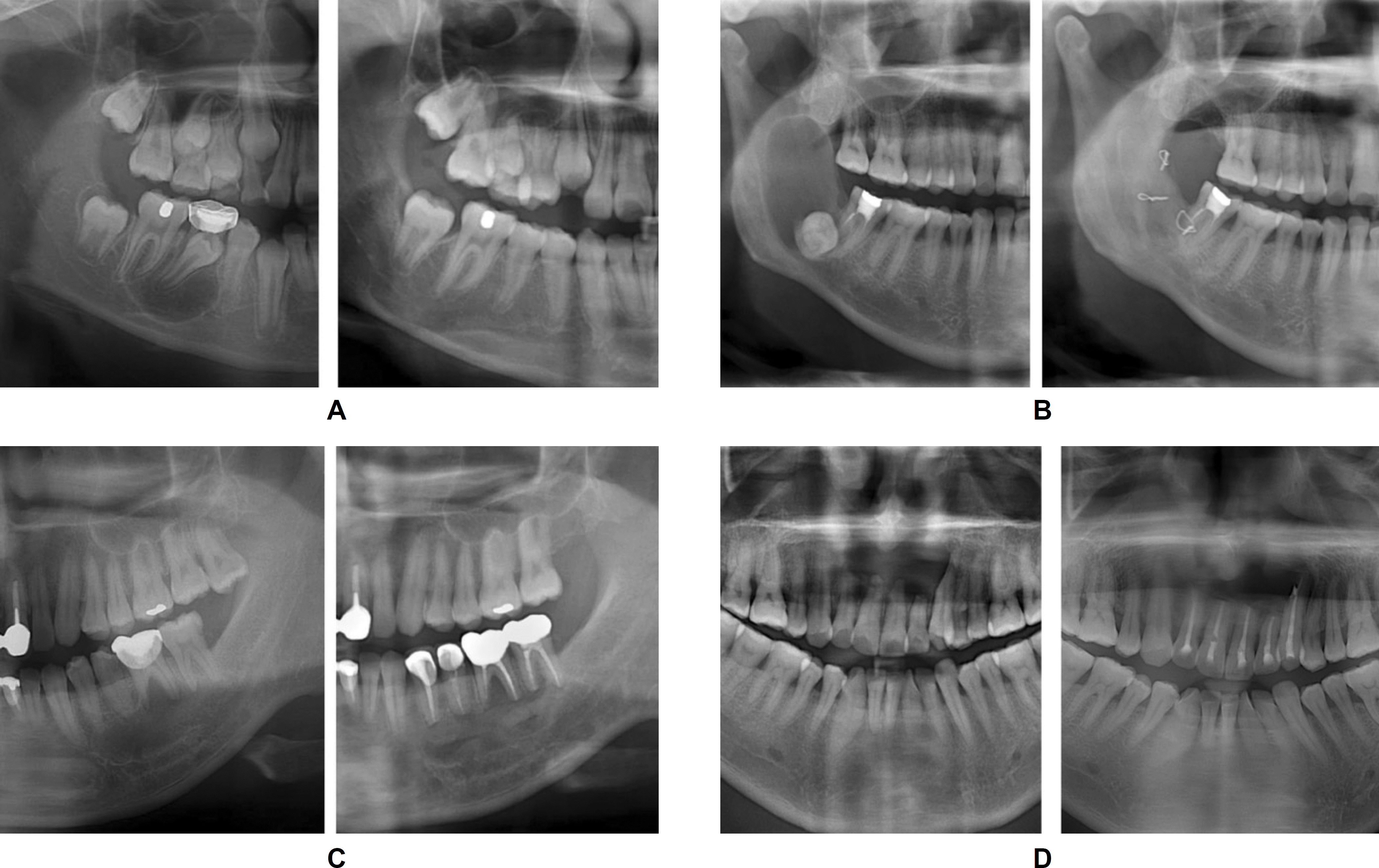Abstract
Introduction
Bone defects in the jaw are frequently observed after odontogenic cyst enucleation. The success of bone healing appears to be related to the size of the bone defect, the anatomical location, the patient’ s age and other parameters. The use of bone grafting material is dependent on the operator’ s preference. No evidence-based definite treatment protocol has been established. This study evaluated the effect of a bone graft into the defect after odontogenic cyst enucleation.
Materials and Methods
A total of 55 patients, who had been treated for an odontogenic cyst with cyst enucleation from 2000 to 2009 at the department of Oral and Maxillofacial Surgery, Samsung Medical Center, were included in this study. Patients who were followed-up for more than 1 year were included. Two groups were defined according to the bone graft (with or without a bone graft) after cyst enucleation. The differences in the healing periods and patterns of bone healing were compared clinically and radiologically. The postoperative 1 year radiographs were analyzed for bone healing and density. Statistical analysis was performed using a Pearson chi square test and Wilcoxon rank-sum test.
Go to : 
REFERENCES
1. Jones AV, Craig GT, Franklin CD. Range and demographics of odontogenic cysts diagnosed in a UK population over a 30-year period. J Oral Pathol Med. 2006; 35:500–7.

2. Grossmann SM, Machado VC, Xavier GM, Moura MD, Gomez RS, Aguiar MC, et al. Demographic profile of odontogenic and selected nonodontogenic cysts in a Brazilian population. Oral Surg Oral Med Oral Pathol Oral Radiol Endod. 2007; 104:e35–41.

3. Tortorici S, Amodio E, Massenti MF, Buzzanca ML, Burruano F, Vitale F. Prevalence and distribution of odontogenic cysts in Sicily: 1986-2005. J Oral Sci. 2008; 50:15–8.
4. Br�ndum N, Jensen VJ. Recurrence of keratocysts and decompression treatment. A longterm followup of forty-four cases. Oral Surg Oral Med Oral Pathol. 1991; 72:265–9.
5. Eyre J, Zakrzewska JM. The conservative management of large odontogenic keratocysts. Br J Oral Maxillofac Surg. 1985; 23:195–203.

6. Marker P, Br � ndum N, Clausen PP, Bastian HL. Treatment of large odontogenic keratocysts by decompression and later cystectomy: a longterm followup and a histologic study of 23 cases. Oral Surg Oral Med Oral Pathol Oral Radiol Endod. 1996; 82:122–31.
7. Nakamura N, Mitsuyasu T, Mitsuyasu Y, Taketomi T, Higuchi Y, Ohishi M. Marsupialization for odontogenic keratocysts: longterm followup analysis of the effects and changes in growth characteristics. Oral Surg Oral Med Oral Pathol Oral Radiol Endod. 2002; 94:543–53.

8. Ihan Hren N, Miljavec M. Spontaneous bone healing of the large bone defects in the mandible. Int J Oral Maxillofac Surg. 2008; 37:1111–6.

9. Schaaf H, Lendeckel S, Howaldt HP, Streckbein P. Donor site morbidity after bone harvesting from the anterior iliac crest. Oral Surg Oral Med Oral Pathol Oral Radiol Endod. 2010; 109:52–8.

10. Ricucci D, Lin LM, Spångberg LS. Wound healing of apical tissues after root canal therapy: a longterm clinical, radiographic, and histopathologic observation study. Oral Surg Oral Med Oral Pathol Oral Radiol Endod. 2009; 108:609–21.

11. Halse A, Molven O, Fristad I. Diagnosing periapical lesions-disagreement and borderline cases. Int Endod J. 2002; 35:703–9.
12. Horowitz I, Bodner L. Use of xenograft bone with aspirated bone marrow for treatment of cystic defect of the jaws. Head Neck. 1989; 11:516–23.

13. Dodde R 2nd, Yavuzer R, Bier UC, Alkadri A, Jackson IT. Spontaneous bone healing in the rabbit. J Craniofac Surg. 2000; 11:346–9.

14. Hjorting-Hansen E, Andreasen JO. Incomplete bone healing of experimental cavities in dog mandibles. Br J Oral Surg. 1971; 9:33–40.
Go to : 
Table 1.
Classification by bone healing degree




 PDF
PDF ePub
ePub Citation
Citation Print
Print



 XML Download
XML Download